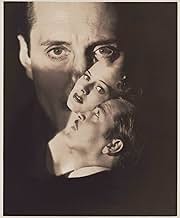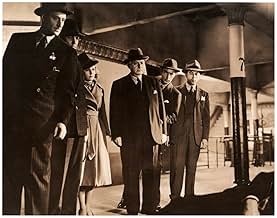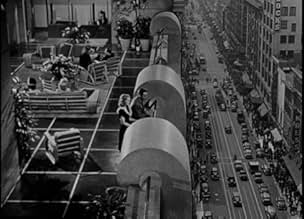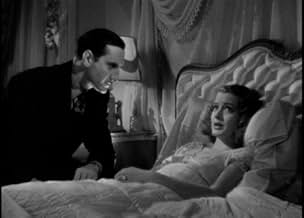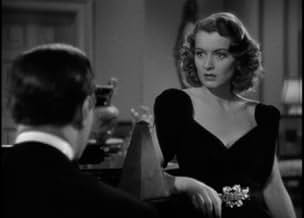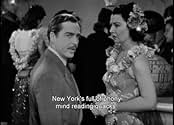अपनी भाषा में प्लॉट जोड़ेंA crazed physician marries a wealthy women and, with the help of his demented assistant, murders them for their money.A crazed physician marries a wealthy women and, with the help of his demented assistant, murders them for their money.A crazed physician marries a wealthy women and, with the help of his demented assistant, murders them for their money.
Barbara Jo Allen
- Louise Watkins
- (as Barbara Allen [Vera Vague])
Bobby Barber
- Bald Man in Library
- (बिना क्रेडिट के)
William 'Billy' Benedict
- Mickey Barnes - Copy Boy
- (बिना क्रेडिट के)
George Chandler
- Elevator Operator
- (बिना क्रेडिट के)
Edward Earle
- Librarian
- (बिना क्रेडिट के)
Chuck Hamilton
- Police Officer at Train Station
- (बिना क्रेडिट के)
Sam Harris
- Passerby
- (बिना क्रेडिट के)
Harry Hayden
- Ticket Clerk
- (बिना क्रेडिट के)
Douglas Kennedy
- Hotel Clerk
- (बिना क्रेडिट के)
Settar Körmükçü
- Dr. David Profesor
- (बिना क्रेडिट के)
John Laing
- Intern
- (बिना क्रेडिट के)
फ़ीचर्ड समीक्षाएं
1940's "The Mad Doctor" is a sadly generic but wholly appropriate title for this Paramount feature, one of their rare genre efforts (working titles "The Monster" and "A Date with Destiny"). In the title role of Dr. George Sebastian, Basil Rathbone is not a 'mad doctor' as in 'mad scientist,' but a psychotic faux psychiatrist living with partner Maurice Gretz (Martin Kosleck), both wanted for murder in Vienna, having relocated to America. With the sudden demise of Sebastian's third wife, he takes up residence in New York City, where he begins another practice, meeting up with potential wife number four, hypochondriac Linda Boothe (Ellen Drew), whom Maurice believes would be the perfect candidate due to her suicidal tendencies (that would save them the trouble of bumping her off). Lurking in the background is Dr. Charles Downer (Ralph Morgan), a longtime friend of Sebastian's late wife, whose suspicions about her untimely death are soon confirmed, at his peril. This Ben Hecht story is loaded with promise, yet fudges its attempts at suspense with sketchy characterizations, virtually none of whom engender any sympathy, particularly the heroine, apparently as dim as the scatterbrained sister (Barbara Allen) that introduced her to Dr. Sebastian. The binding relationship between the doctor and Maurice is by far the most intriguing aspect to the film, but little footage is devoted to their villainy, the pace slowed to a crawl by endless romantic twaddle. The final third almost makes up for all these faults, but the excellent cast is left pretty much on their own. Ellen Drew was much better, and far more sympathetic, in another Paramount, "The Monster and the Girl," while Martin Kosleck easily steals his scenes from the rather surprisingly uninspired Rathbone (much better in "Kind Lady"), soon to enjoy one of his finest villains opposite Tyrone Power in "The Mark of Zorro."
I remember seeing THE MAD DOCTOR on TV back in the early 1960s and although I didn't see it again until the release of this Blu-Ray half a century later, parts of it, especially the ending, had remained with me. Why this film has not made its bow on home video until now is beyond me. It's an A Movie, as can be seen by the big budget, but with B Movie sensibilities regarding its use of character players outside of Rathbone and its overall Film Noir look which is due to cinematographer Ted Tetzlaff. Even the title sounds like a B Movie. However the strongest element in the whole mix is the screenplay. More about that later.
The plot concerns a suave Svengali-like psychiatrist played by Rathbone who marries wealthy women and then disposes of them. He meets a wealthy socialite who has suicidal tendencies (Ellen Drew) and plans to make her his next victim. Can her reporter boyfriend (John Howard), whom she has rejected, save her in time? Nothing out of the ordinary there. What IS different in THE MAD DOCTOR is the relationship between Rathbone and his constant companion played by Martin Kosleck. It is clearly a gay relationship in everything but name and how it got past the 1940 censors is a question worth asking.
The screenplay was originally written by top writers Ben Hecht & Charles MacArthur in the early 1930s and intended for John Barrymore (hence the Svengali angle). It was originally called "The Monster" and later "Destiny". That explains the quality dialogue which is one of the movie's highlights. When Barrymore bowed out, the script sat on the shelf for 5 years before Paramount used it. They had changes made by Howard W. Green who received sole screen credit. Although full of dark moments, there is a lightness of touch from director Tim Whelan which adds to the enjoyment. Kino deserves credit for resurrecting this forgotten gem. Once you see it, you'll wonder why it stayed hidden for so long...For more reviews visit The Capsule Critic.
The plot concerns a suave Svengali-like psychiatrist played by Rathbone who marries wealthy women and then disposes of them. He meets a wealthy socialite who has suicidal tendencies (Ellen Drew) and plans to make her his next victim. Can her reporter boyfriend (John Howard), whom she has rejected, save her in time? Nothing out of the ordinary there. What IS different in THE MAD DOCTOR is the relationship between Rathbone and his constant companion played by Martin Kosleck. It is clearly a gay relationship in everything but name and how it got past the 1940 censors is a question worth asking.
The screenplay was originally written by top writers Ben Hecht & Charles MacArthur in the early 1930s and intended for John Barrymore (hence the Svengali angle). It was originally called "The Monster" and later "Destiny". That explains the quality dialogue which is one of the movie's highlights. When Barrymore bowed out, the script sat on the shelf for 5 years before Paramount used it. They had changes made by Howard W. Green who received sole screen credit. Although full of dark moments, there is a lightness of touch from director Tim Whelan which adds to the enjoyment. Kino deserves credit for resurrecting this forgotten gem. Once you see it, you'll wonder why it stayed hidden for so long...For more reviews visit The Capsule Critic.
Strangely lacklustre reviews to this quite novel 1940 Noir. Insightful, knowledgeable scripting, wonderful schwartz photography from Ted Tetzlaff. A sinister Rathbone undulating between predator and smitten, with both his male accomplice and the full lips of Ellen Drew on the way to more resolute acting ahead. The opening 10 minute rainstorm introduces the maelstrom perfectly and it continues at a good pace, with a variety of well edited sequences adding to the narrative flow, the high night time shots above 5th Avenue conjured well by subtle SFX. The ubiquitous Ben Hecht had a hand in the screenplay, alongside Harold J. Green, and it shows in this robust, ballsy psycho-drama.
This Unusual Film "Forecasts" an Anticipation of a Sub-Genre of Film-Noir. The Mental-Health Field...
It was Perhaps, the Dark Genre Most Go-To Subject-Matter with Psychiatry and the Many Unknowns and Rife with Controversy.
To Diagnosis Apart from the Usual Scientific Method that Resulted in "Evidence" from the Material-World.
The Methods Used in the Dual Practices of "Health-Care" were Mostly Diametrically Opposed in the Historical-Record. But with Sigmund Freud and His Peers Bringing the Field into Close Proximity "Hard-Science".
Treating Suffering Patients Needs, by Qualified Practitioners, Should be Taken Seriously. Not Dismissed and Ridiculed.
In 1940, the "Mad" in the Title Makes the Movie Sound Like a "Horror Movie". But, This Film Never Stray from its Roots of "Thriller",
It Explores Very-Dark, Complex Behavior.
Basil Rathbone Creating Charm, a Suave Demeanor, with a Confident Delivery of His "Svengali-Like" Power,
Dreamy-Eyed Ellen Drew is Overwhelmed by a Childhood Death or Her Father, by Suicide with Ensuing Nightmares.
She is Fine as a Victim of Trauma, and Handles the Complexity with an Essential Performance.
Another Reason this Forgotten Film is Required Viewing...
A Quirky Element that was Extremely Rare and Almost Non-Existent in "The Code" Years. An In-Your-Face Gay Couple. The Movie Doesn't Try and Hide it, although it Never Verbally Reveals it, but it's On-Screen with a Multitude of Stereo-Typical Behavior by Rathbone and His Companion.
It's On-Screen for Every-One from the Trailer-Park to the Penthouse to Understand. It's there, No Subtlety.
"The Mad Doctor" is a Hidden-Gem...
Wildly Unknown, and a Treat for Film-Fans that Love Discovering and Appreciating Movies that have a Certain Anti-Routine Approach and Takes Chances...
Willing to Create Outside Conventional Attitudes and Expectations in the World of "The Most Popular Art-Form of the 20th Century".
It was Perhaps, the Dark Genre Most Go-To Subject-Matter with Psychiatry and the Many Unknowns and Rife with Controversy.
To Diagnosis Apart from the Usual Scientific Method that Resulted in "Evidence" from the Material-World.
The Methods Used in the Dual Practices of "Health-Care" were Mostly Diametrically Opposed in the Historical-Record. But with Sigmund Freud and His Peers Bringing the Field into Close Proximity "Hard-Science".
Treating Suffering Patients Needs, by Qualified Practitioners, Should be Taken Seriously. Not Dismissed and Ridiculed.
In 1940, the "Mad" in the Title Makes the Movie Sound Like a "Horror Movie". But, This Film Never Stray from its Roots of "Thriller",
It Explores Very-Dark, Complex Behavior.
Basil Rathbone Creating Charm, a Suave Demeanor, with a Confident Delivery of His "Svengali-Like" Power,
Dreamy-Eyed Ellen Drew is Overwhelmed by a Childhood Death or Her Father, by Suicide with Ensuing Nightmares.
She is Fine as a Victim of Trauma, and Handles the Complexity with an Essential Performance.
Another Reason this Forgotten Film is Required Viewing...
A Quirky Element that was Extremely Rare and Almost Non-Existent in "The Code" Years. An In-Your-Face Gay Couple. The Movie Doesn't Try and Hide it, although it Never Verbally Reveals it, but it's On-Screen with a Multitude of Stereo-Typical Behavior by Rathbone and His Companion.
It's On-Screen for Every-One from the Trailer-Park to the Penthouse to Understand. It's there, No Subtlety.
"The Mad Doctor" is a Hidden-Gem...
Wildly Unknown, and a Treat for Film-Fans that Love Discovering and Appreciating Movies that have a Certain Anti-Routine Approach and Takes Chances...
Willing to Create Outside Conventional Attitudes and Expectations in the World of "The Most Popular Art-Form of the 20th Century".
Doctor Ralph Morgan calls at Basil Rathbone's home. His patient, Rathbone's wife, has died. Morgan is suspicious; she was recovering. He does nothing about it.
His suspicions are justified. Rathbone speaks with his manservant, Martin Kosleck, of how much he despised his rich wife and her stupid town, just like his other victims. They will return to New York, and he to his practice as a psychiatrist. There he is hired to deal with Ellen Drew, a depressed and suicidal socialite whose newspaper boyfriend, John Howard, has his suspicions. His investigations lead him to Morgan, even as Miss Drew marries Rathbone.
Rathbone offers his usual graceful performance as a man struggling with redemption. Most noteworthy of all, however, is Ellen Drew's performance as someone suicidal when we first meet her, to someone lighthearted after the ordinary pleasures of Coney Island. Alas, there is no sign of revival of her psychoses at the end, but in that era, endings had to be happy, even in a movie that focuses on Rathbone's attempts to deal with his own dark desires.
Hecht and MacArthur did uncredited work on the script, and they undoubtedly gave the producers what they asked for; neither was director Tim Whelan the man to stand up for a darker vision; he had returned to the US doing work on Korda's THE THIEF OF BAGDAD, and this was his first movie after that. It was no time to antagonize the brass at Paramount.
His suspicions are justified. Rathbone speaks with his manservant, Martin Kosleck, of how much he despised his rich wife and her stupid town, just like his other victims. They will return to New York, and he to his practice as a psychiatrist. There he is hired to deal with Ellen Drew, a depressed and suicidal socialite whose newspaper boyfriend, John Howard, has his suspicions. His investigations lead him to Morgan, even as Miss Drew marries Rathbone.
Rathbone offers his usual graceful performance as a man struggling with redemption. Most noteworthy of all, however, is Ellen Drew's performance as someone suicidal when we first meet her, to someone lighthearted after the ordinary pleasures of Coney Island. Alas, there is no sign of revival of her psychoses at the end, but in that era, endings had to be happy, even in a movie that focuses on Rathbone's attempts to deal with his own dark desires.
Hecht and MacArthur did uncredited work on the script, and they undoubtedly gave the producers what they asked for; neither was director Tim Whelan the man to stand up for a darker vision; he had returned to the US doing work on Korda's THE THIEF OF BAGDAD, and this was his first movie after that. It was no time to antagonize the brass at Paramount.
क्या आपको पता है
- ट्रिवियाOne of over 700 Paramount Productions, filmed between 1929 and 1949, which were sold to MCA/Universal in 1958 for television distribution, and have been owned and controlled by Universal ever since; its earliest documented telecast took place in Seattle Monday 11 May 1959 on KIRO (Channel 7).
- गूफ़At the Library, Sebastien shades over a page with a pencil to see the impression of what was written there earlier but when he tears the page off the pad, the page is untouched.
- भाव
Maurice Gretz: You're like all the other clever ones, clever until they meet a woman, and then they suddenly become fools.
- कनेक्शनReferenced in Svengoolie: Night Monster (2015)
- साउंडट्रैकAloha 'Oe
Music by Queen Liliuokalani
टॉप पसंद
रेटिंग देने के लिए साइन-इन करें और वैयक्तिकृत सुझावों के लिए वॉचलिस्ट करें
- How long is The Mad Doctor?Alexa द्वारा संचालित
विवरण
- चलने की अवधि1 घंटा 30 मिनट
- रंग
- पक्ष अनुपात
- 1.37 : 1
इस पेज में योगदान दें
किसी बदलाव का सुझाव दें या अनुपलब्ध कॉन्टेंट जोड़ें

